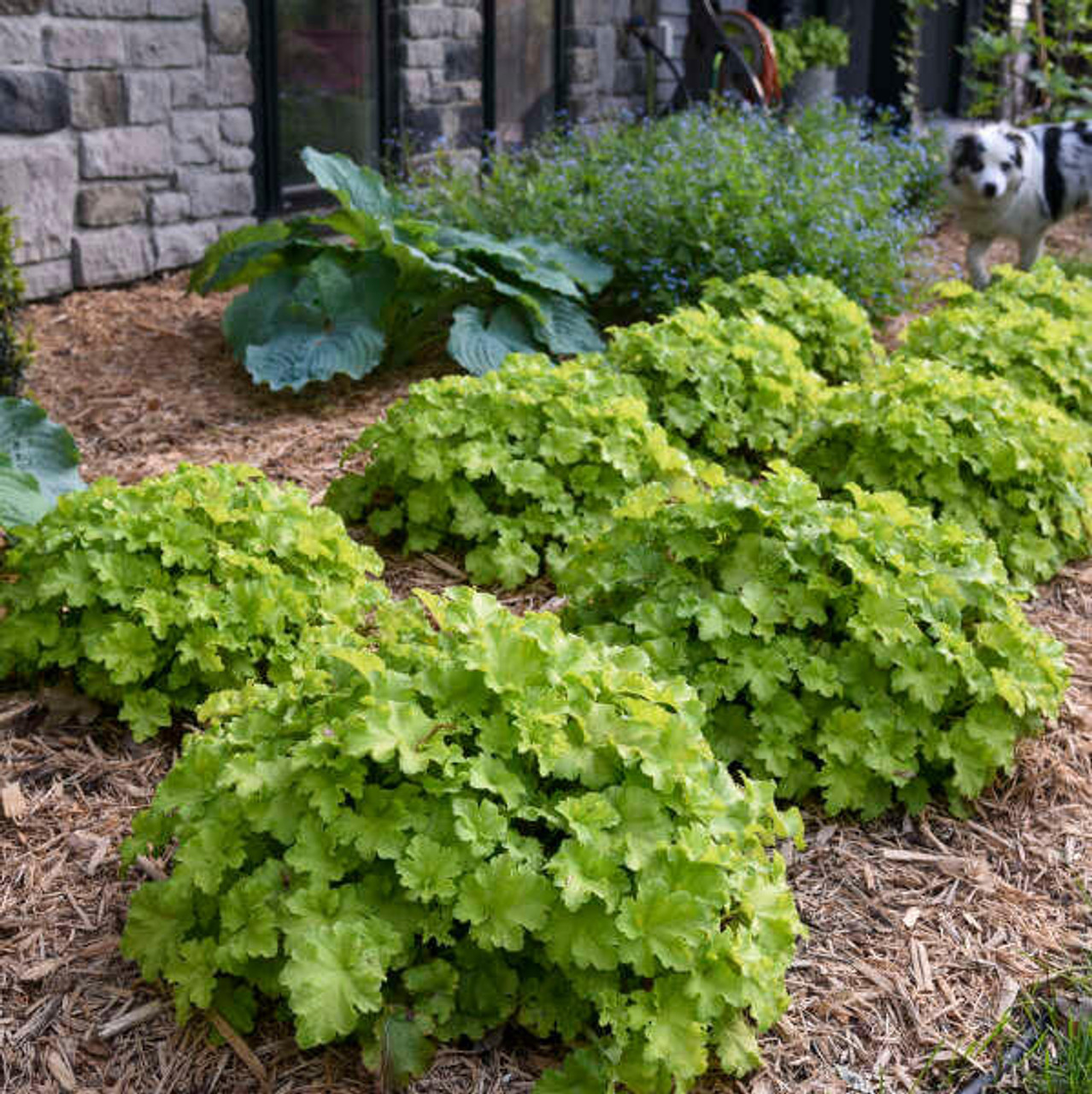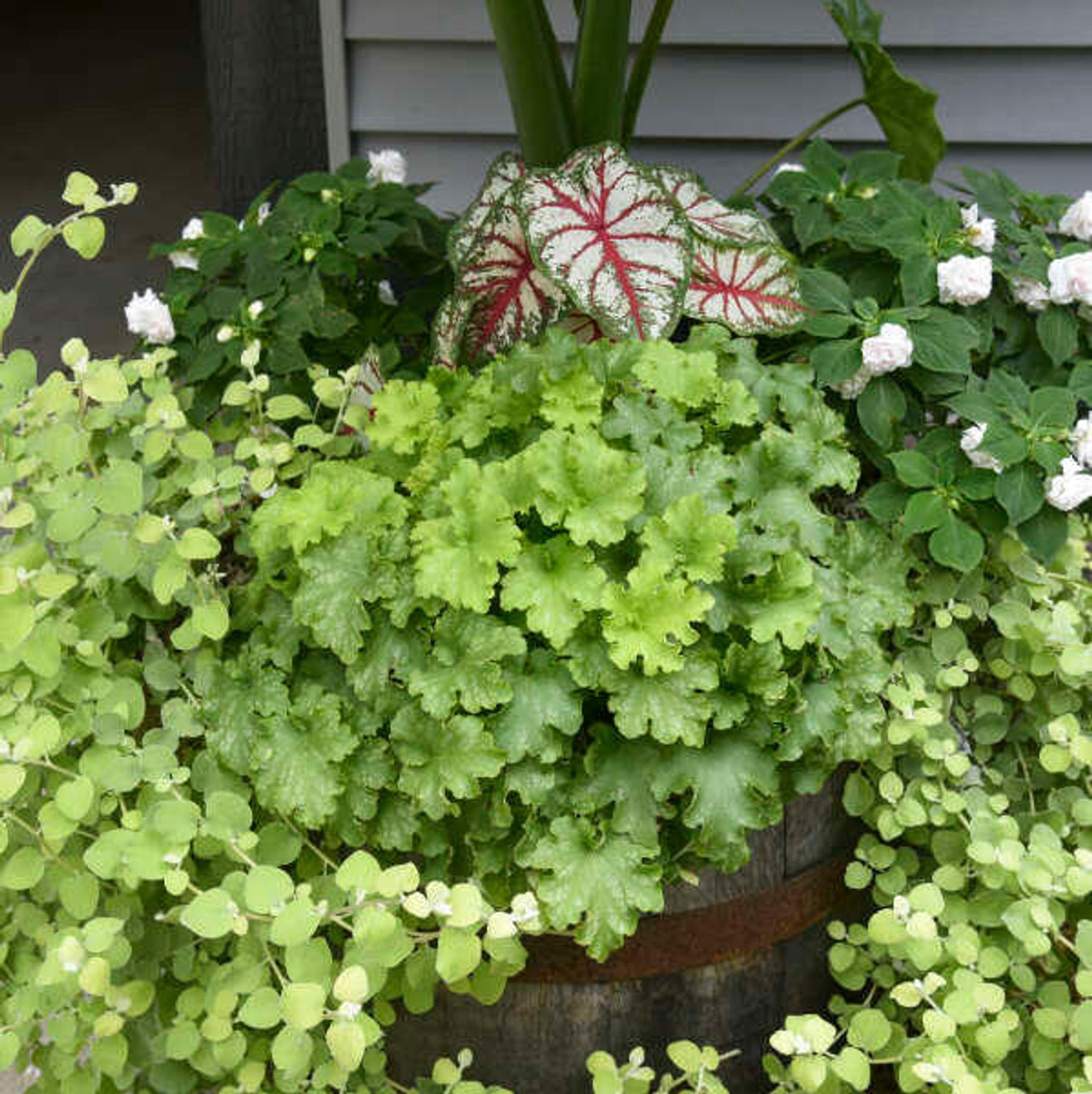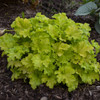Product Description
Heuchera 'Apple Twist' PP31221 CPBRAF (20)ct Flat
DOLCE® series
Common Name: Coral Bells
It's always apple season with this Heuchera! Watch with delight as this unique plant changes throughout the seasons. Newly emerging leaves have red veining that lightens with age. Chartreuse yellow leaves have wavy, rippled edges that will mature to apple green leaves later in the season. You'll appreciate its dense, full habit and good vigor.
Coral bells are easy to grow and blend easily with most other perennials in the landscape. Because of their low, mounding habit, they are often used as edging along paths or in containers. Try cutting a few of the tall flower scapes for fresh bouquets.
Heucheras are easy perennials to grow and fit nicely in the front of any border, rock garden, or container. They grow most vigorously and have the stongest colors when grown in partial shade (preferably afternoon shade). They can also be grown in full shade, but their growth rate will be very slow. Some varieties can withstand full sun in northern climates if they have consistant moisture, but their colors tend to fade with the intensity of the sun. The soil should be amended with organic matter prior to planting. It should also have good drainage and a neutral pH.
Heucheras are evergreen in areas with mild winters. If properly sited out of the way of winter winds and with reliable snow cover, gardeners in northern regions may also find their heucheras acting as evergreens. If the plant looks tattered by early spring, shear off any damaged leaves to make room for the vibrant new foliage which will fill in quickly.
Heucheras can be grown under Black Walnut trees because they are resistant to the toxin Juglone which the trees emit from their roots.
Heucheras are also salt tolerant. They are useful in the north along pathways which are salted in winter or for people gardening in coastal regions. Occasionally in northern regions, heucheras have a tendancy to heave out of the ground because of the freeze/thaw cycle. To combat heaving, add an extra layer of compost around the plant's roots in the fall. In the spring, if the plants have heaved at all, the new roots will grow into the fresh new layer of compost.
Height: 10.0-12.0 Inches
Spread: 20.0-24.0 Inches
Scape Height: 18.0-20.0 Inches
Hardiness Zones: 4,5,6,7,8,9
Flower Color: White Shades
Foliage Color: Yellow shades
Full Sun (> 6 hrs. Direct Sun) to Full Shade (< 4 hrs. Direct Sun)
Average Water Needs
Poor to Average Soil Quality
Bloomtime: Midsummer
Attracts Butterflies
Attracts Hummingbirds
Bee Friendly
Deer Resistant
Evergreen
Growth Rate: Medium
Border Plant, Cut Flower, Cut Foliage, Easy To Grow, Edging, Attractive Foliage, Mass Planting, Salt Tolerant
Heuchera 'Apple Twist', also known as coral bells, is a captivating perennial celebrated for its vibrant, color-changing foliage and delicate blooms. This comprehensive guide explores the key characteristics, care requirements, and versatile uses of this remarkable plant, making it an ideal choice for both novice and seasoned gardeners.
Characteristics of Heuchera 'Apple Twist' Heuchera 'Apple Twist' is a hybrid variety belonging to the Dolce® series developed by Proven Winners. This compact, mounding perennial typically reaches a height of 10-12 inches with a spread of 20-24 inches at maturity. Its most striking feature is its foliage, which undergoes a fascinating transformation throughout the growing season. New leaves emerge with a reddish tint and prominent red veining, gradually transitioning to a vibrant chartreuse-yellow with wavy, rippled edges. As the season progresses, the foliage matures to a refreshing apple green, providing a dynamic display of color. This unique characteristic, where the foliage changes color throughout the seasons, sets Heuchera 'Apple Twist' apart from other varieties. In mid-summer, delicate cream-colored flowers bloom on tall, slender stems, adding a touch of elegance to the already eye-catching foliage. The flower type is a panicle.
Heuchera 'Apple Twist' is a native plant and thrives in USDA hardiness zones 4-9. It prefers partial shade to full shade, tolerating up to 4 hours of direct sunlight daily. This adaptability makes it a versatile choice for various garden settings. It is also known for its drought tolerance, deer resistance, and ability to attract pollinators such as butterflies and hummingbirds. It has an average growth rate and is salt tolerant.
Care Requirements Heuchera 'Apple Twist' is a low-maintenance plant, making it suitable for beginners, but proper care ensures optimal growth and vibrant foliage. Here are some essential care tips:
- Hardiness Zones: Heuchera 'Apple Twist' thrives in USDA hardiness zones 4-9.
- Soil: Well-drained soil is crucial, especially in shady areas, to prevent root rot. Amending the soil with organic matter before planting improves drainage and provides essential nutrients. The soil should have a neutral pH.
- Light: While it thrives in shade, some direct sunlight enhances the foliage color. Avoid excessive sun exposure, as it can cause the leaves to scorch.
- Water: Keep the soil evenly moist but not consistently wet. Water thoroughly when the soil dries slightly to prevent overwatering.
- Fertilizing: Apply an all-purpose garden fertilizer in spring to promote healthy growth.
- Winterizing: In colder climates, apply a 2-3 inch layer of mulch around the base of the plant to protect the roots from freezing and thawing. To prevent frost heaving, add an extra layer of compost around the plant's roots in the fall.
- Pruning: Remove old, tattered leaves in early spring before new growth emerges. Cut back flower stalks after blooming to encourage foliage growth.
- Diseases: Be mindful of potential diseases such as Rhizoctonia crown rot and Botrytis.
Versatile Uses in the Garden Heuchera 'Apple Twist' offers a wide range of uses in the garden, thanks to its compact size, attractive foliage, and adaptability. This makes it a great choice for gardeners with different needs and preferences. Some popular applications include:
- Accents: Its vibrant foliage creates striking focal points in shady gardens or borders, adding a pop of color and visual interest.
- Borders: Plant them along walkways or garden edges to add texture and color definition.
- Container Gardening: Their compact size makes them ideal for containers, adding a touch of elegance to patios and balconies.
- Edging: Use them to define garden beds or pathways, creating a neat and colorful border.
- Ground Cover: Plant them in masses to create a lush, colorful ground cover in shady areas.
- Mass Planting: Create a dramatic effect by planting them in groups, showcasing their vibrant foliage.
- Rain Gardens: Their tolerance for varying moisture levels makes them suitable for rain gardens.
- Underplanting: Their shade tolerance makes them perfect for underplanting trees or shrubs.
- Woodland Gardens: Their natural appearance blends seamlessly into woodland settings.
- Cut Flowers: The tall flower scapes can be used in fresh bouquets, adding a unique touch to floral arrangements.
- Living Walls: Heuchera 'Apple Twist' can be incorporated into living walls, adding texture and color to vertical gardens.
Companion Planting Ideas Proven Winners offers two planting recipes that include Heuchera 'Apple Twist':
- Wine Tour: This recipe combines Heuchera 'Apple Twist' with Shadowland® 'Coast to Coast' Hosta and Primo® 'Mahogany Monster' Coral Bells for a stunning display of foliage color and texture.
- Caramel Glaze: This recipe pairs Heuchera 'Apple Twist' with Fun and Games® 'Eye Spy' Foamy Bells and Primo® 'Peachberry Ice' Coral Bells for a vibrant and eye-catching combination.
These recipes provide inspiration and ideas for combining Heuchera 'Apple Twist' with other plants to create beautiful and dynamic garden displays.
Heuchera 'Apple Twist' is a versatile and captivating perennial that adds a touch of magic to any garden. Its color-changing foliage, delicate blooms, and adaptability make it a favorite among gardeners. Whether used as an accent, border, or ground cover, this plant is sure to bring life and vibrancy to your outdoor space. With proper care and attention, Heuchera 'Apple Twist' will reward you with its beauty for years to come. Consider exploring the different varieties of Heuchera and adding this delightful plant to your garden.
Other Details
The most important part of the plant is its root system. Healthy roots are the foundation of a healthy, vibrant plant. The type of plug container used is based on the specific needs of the plants. Perennials offered as bare root traditionally perform better when planted as bare root.Planted in a specialized mix, potted plants have well established root systems. Top growth stage will vary depending on the current life cycle and time of year when shipped. In Winter and early Spring dormant plants may be shipped. Dormant plants may be planted right away, even before the last frost date.
Most bare root varieties are field grown for at least one season, though Hemerocallis and Hosta are grown for two seasons. The bulk of the soil is removed during the harvesting process and the tops of most varieties are trimmed back to the crown. They are graded, packed in shredded aspen or sphagnum moss and stored in freezers until ready to be shipped.
See our Container Sizes and Bare Root Perennials pages for more information.
Plant information and care is provided in the Overview section, Plant Genus Page and general information is provided in the Planting Care & Guides. Additional questions can be asked on each Plant page.
Plant Spacing: Using the maximum mature spread or width of a plant to guide spacing, ensures space to grow to full size. To fill an area sooner, plant them closer together. Just remember, future thinning or transplanting may be needed.
Water: Keep a close eye on newly planted perennials, especially throughout the first growing year. Most early plant loss is due to too much or too little water!

















